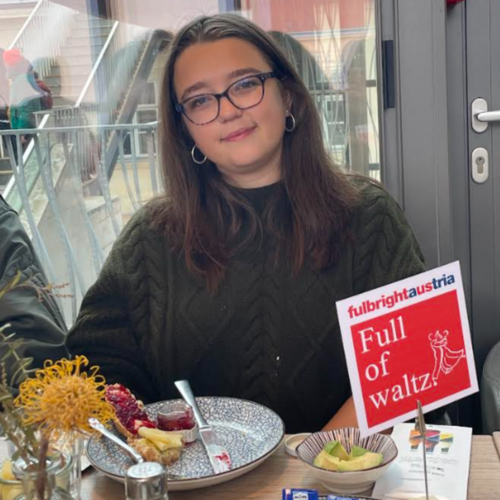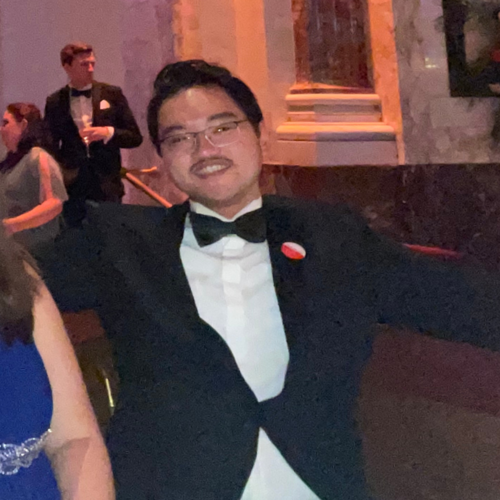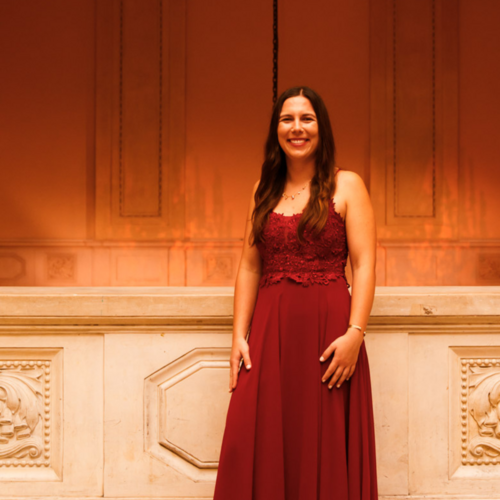Every year, Fulbright Austria and members of the community dance until their feet are sore at the TU Ball. The next morning, the community once again come together at a post-ball brunch to swap stories about the ball and re-energize. The ball experience is an unforgettable part of exploring Viennese and Austrian culture, and three community members wrote about their individual experience at the ball and the post-ball brunch. We hope you enjoy browsing through the photo album and reading our program participants’ stories!
TU Ball 2025 and post-ball brunch: Recap
10 February 2025Browse through photos and read first-person accounts from the ball and the post-ball brunch.
Photo album
First-person accounts
Eleanor Rueffer
2024–25 US Fulbright combined grantee
Attending the TU Ball with Fulbright Austria was an unforgettable experience. In many ways, it felt like a replacement for the prom I never had due to the COVID-19 pandemic. One of the highlights leading up to the event was the process of finding the perfect formal, floor-length gown. I went dress shopping with my mother while home in the United States over the Christmas break, an experience that allowed me to involve my family in my life abroad.
Arriving in Vienna and approaching the Hofburg was truly magical. The grand entrance, filled with elegantly dressed guests, felt like stepping back in time. The sweeping staircase provided the perfect backdrop for photos, and my friends and I took full advantage of the opportunity. Inside the main ballroom, we found a spot to take in the breathtaking opening waltz, catching glimpses of the dancers through the crowd as everyone vied for the best view.

After the formal opening remarks, the Fulbright Austria group gathered for a photo. It was a wonderful opportunity to reconnect with fellow USTAs from orientation and meet many others whom I hadn’t had the chance to interact with before. It was also a pleasure to see the dedicated Fulbright Austria team again, as they had played such an important role in welcoming us to Austria. The event fostered a strong sense of community, and it was heartwarming to share this experience with so many like-minded individuals who were also navigating life abroad.
As the night continued, we wandered through the Hofburg, discovering different ballrooms and dance floors, each with its own unique ambiance. The variety of music was astounding—while one room featured traditional waltzes, another had lively jazz, and yet another hosted contemporary music, allowing guests to experience a diverse range of dance styles throughout the night. The grandeur of the venue made every moment feel special, and I was struck by how seamlessly history and tradition blended with the joy and energy of the present.
I stayed until the very end at 5 AM, and it was truly one of the most memorable nights of my life. The following morning, we gathered once more for the Fulbright brunch, where we enjoyed a delicious spread and the opportunity to reflect on the incredible experience together. It was the perfect conclusion to an extraordinary event.
Nathaniel Dela Pena
2024–25 US teaching assistant
At our brunch that followed the evening at the Hofburg, executive director Hermann Agis made a quite accurate comment. To paraphrase what he said, Austrians may not have their own Super Bowl, but Vienna certainly has its own “super balls” (in reference, of course, to Vienna’s ball season).
Certainly, the TU Ball was a stellar experience and a perfect introduction to Vienna’s world famous “super balls.” As a first-time observer, I found the unity between tradition and modernity intriguing. We can start with the choice of venue: the Hofburg. The ornate chandeliers, the marble walls, and the red carpet teleport you back to the 19th century. While the traditional waltzes, strict dress code, and the Hofburg from the Imperial era remain, the makeup of those at the ball has certainly changed. We came from all backgrounds, creeds, and classes. As a Filipino American, I would never imagine that I would be dancing in the main palace of the Habsburg dynasty, of which Philip II of Spain (whom the Philippines was named after) was a part.

The night started with the introduction of the Jungdamenkomittee and the Jungherrenkomittee in the Festsaal. I was enchanted with the orderly nature of the opening ceremony and the coordination of those on the floor. Apart from a tree spontaneously falling over, the ceremony went well. The young students gleefully waltzed around, and we could only enviously stare while sitting at our tables. Once the ceremony was done, we went over to the main stairs and took our pictures.
As the night went on, the night got a little less traditional and more modern. With a partner, I bunny-hopped during the Mitternachtsquadrille. I also danced with friends in the middle of the Festsaal. While I was not the best dancer, the camaraderie with friends and introduction to more USTAs from other regions in Austria made the night special.
In addition to the elegant Festsaal, there were other rooms where one could dance to one’s content. For instance, in the Zeremoniesaal, one could listen to jazz. If Latin music is more of your style, you could have gone to the Forum. Lastly, if the traditional music bored you, you could have gone to the basement rooms of the Hofburg and danced to more modern songs. Hearing a techno version of “Take Me Home, Country Roads” by John Denver capped off my night in Vienna, just in time for the first U-Bahn to take me home to my hotel. Admittedly, my definition of the “night” ends a bit earlier than 5:00 in the morning, but when in Vienna, do as the Viennese do.
Paige Liebel
2024–25 US Fulbright student
I prefer ski boots to heels. That’s at least what I grumbled to myself as I maneuvered from the U-bahn to the doors of the Hofburg, already feeling my toes pinching in anger. I did not appreciate how the grace I typically exhibit while effortlessly connecting carving turns down the slopes in Tyrol was stripped away as I attempted to ascend the grand stairwell. The length of my evening dress appeared to be more of an impediment to remaining upright than an ice patch on the mountain. My grumblings quieted as I stepped into the main ballroom. I personally find it difficult to speak when your breath is ripped away.
There I stood, shoulder to shoulder with fellow Fulbrighters, taking in a scene that was as historic as it was extravagant. The dance floor sparkled with debutantes in white, an orchestra filled the room with live music, and even palm trees found a place on the walls amid a Viennese winter. Buckets overflowed with Austrian Schlumberger brut, and the atmosphere exuded a carefree yet refined joy—a form of relaxed hedonism that we, often absorbed in our scholarly pursuits, rarely allow ourselves.

As I danced and wandered from room to room—where I encountered a cappella groups, jazz bands, and professors sharing meals of Wurst and Brezel with their students—I couldn’t help but reflect on the rich past embedded in those walls. I imagined the centuries of revelry, the countless young scholars, aspiring scientists, and artists who had once celebrated here in the same fashion that I was now. It was not a stifling sense of history but rather a living tradition, a seamless bridge linking the past and present. This connection lent a profound gravity to the evening, deepening the joy of our indulgence.
The splendor of the ball is a reminder of the immense effort and human ingenuity that have converged over the centuries—from the craftsmanship that built the palace and designed the evening gowns to the innovations that illuminated the rooms and the meticulous art of winemaking that produced the Sekt that we were sipping on. It is an encompassing celebration of life’s grandeur and the sheer serendipity that allowed such a moment to occur. This led to the overwhelming feeling of fortune. How can’t I feel lucky? I am lucky to be a Fulbrighter, lucky to build bridges with Austrians through people-to-people cultural exchange, lucky to pursue research, lucky to be the first American that many Austrians encounter, and, yes, even lucky to wear heels for an evening.
Moments like the TU Ball inspire me to continue striving for personal and professional growth. They remind me to play my part so that future generations can experience the same magic I felt during that unforgettable evening in Vienna. Fulbright experiences such as these shape Fulbright Austria’s program participants to be aware of the cumulative human effort that makes our lives possible and to direct their energy to contribute to it.
Many thanks to the individuals and the educational and cultural exchanges that made this extraordinary experience possible. I know that I am not alone in my gratitude.